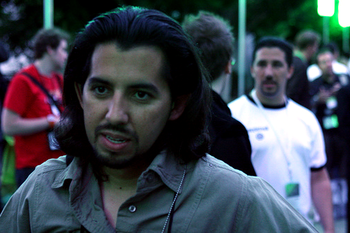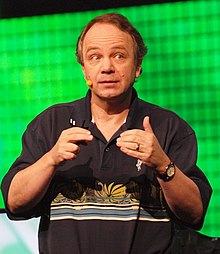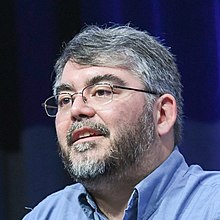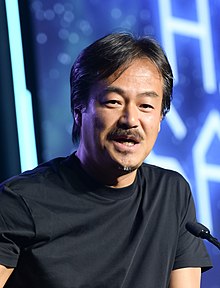Portal:Video games
The Video Games Portal

A video game, also known as a computer game or just a game, is an electronic game that involves interaction with a user interface or input device (such as a joystick, controller, keyboard, or motion sensing device) to generate visual feedback from a display device, most commonly shown in a video format on a television set, computer monitor, flat-panel display or touchscreen on handheld devices, or a virtual reality headset. Most modern video games are audiovisual, with audio complement delivered through speakers or headphones, and sometimes also with other types of sensory feedback (e.g., haptic technology that provides tactile sensations). Some video games also allow microphone and webcam inputs for in-game chatting and livestreaming.
Video games are typically categorized according to their hardware platform, which traditionally includes arcade video games, console games, and computer (PC) games; the latter also encompasses LAN games, online games, and browser games. More recently, the video game industry has expanded onto mobile gaming through mobile devices (such as smartphones and tablet computers), virtual and augmented reality systems, and remote cloud gaming. Video games are also classified into a wide range of genres based on their style of gameplay and target audience. (Full article...)
Featured articles –
After Sonic the Hedgehog greatly increased the popularity of the Genesis in North America, Sega directed STI founder Mark Cerny to start Sonic 2 in November 1991. Members of the original development team—including programmer Yuji Naka and designer Hirokazu Yasuhara—moved from Japan to California to join the project. Sonic 2 was intended to be faster and more ambitious than the first game. The development suffered setbacks, including cultural differences between the Japanese and American staff, and numerous levels were cut due to time constraints and quality concerns. As with the first game, Masato Nakamura, a member of the J-pop band Dreams Come True, composed the soundtrack.
Sonic 2 was widely anticipated, and Sega backed it with an aggressive $10 million marketing campaign. It was released in November 1992 to acclaim and received numerous year-end accolades, including two Golden Joystick Awards. Critics considered Sonic 2 an improvement over the first game and praised the visuals, level design, gameplay, and music, though the low difficulty level and similarities to its predecessor were criticized. Sonic 2 grossed over $450 million and sold six million copies by 2006, making it the second-bestselling Genesis game behind the original Sonic the Hedgehog. (Full article...)
After releasing Halo 3 in 2007, Bungie split into teams to develop two different games—what would become Halo 3: ODST and Reach. The developers decided to create a prequel to the original Halo game trilogy, freeing themselves from the obligation of addressing old story threads. As the game would take place on a human world doomed to be destroyed, they focused on making the environment a character unto itself. Longtime Halo composers Martin O'Donnell and Michael Salvatori returned to compose Reach's music, aiming for a more somber sound to match the story.
Reach was announced at E3 2009 in Los Angeles, and the first in-engine trailer was shown at the 2009 Spike Video Game Awards. Players who purchased ODST were eligible to participate in a Reach multiplayer beta in May 2010; the beta allowed Bungie to gain player feedback for fixing bugs and making gameplay tweaks before shipping the final version. Microsoft gave Reach its biggest game marketing budget yet and created award-winning live-action commercials, action figures, and interactive media to promote the game. (Full article...)
In Conan, the hero is on a quest to recover his lost armor and defeat an evil wizard. Conan can fight with sword and shield, two-handed weapons, or a weapon in each hand. Starting with several basic attacks, the barbarian gains experience points by killing enemies. By exchanging these points for additional attacks, players improve the hero's fighting abilities. Magic powers complement Conan's arsenal, including the abilities to turn enemies into stone and conjure firestorms. The game also features context-sensitive action sequences in which players press a sequence of buttons displayed on the screen to complete actions such as killing powerful enemies and interacting with the environment.
Critics enjoyed Conan's combat system and gory kills, but said the game failed to match the experience offered in God of War. Reactions varied on the game's depiction of the Conan universe; several critics praised the emulation of Frank Frazetta's famous artwork, but others found the game's graphics drab and of low resolution. Regarding the audio, Golden Globe-winning actor Ron Perlman was both praised and criticized for his voice work as Conan. Composer Mike Reagan received acclaim for the game's music and later gave live performances of the game's soundtrack at Video Games Live shows. Despite the average reviews and commercial success of the Conan franchise, Conan sold poorly and was a financial loss for THQ. (Full article...)
Nintendo Entertainment Analysis & Development developed the game, led by director Takashi Tezuka and producer and series creator Shigeru Miyamoto. It is the first Mario game for the SNES and was designed to make the most of the console's technical features. The development team had more freedom compared to the series installments for the Nintendo Entertainment System (NES). Yoshi was conceptualised during the development of the NES games but was not used until Super Mario World due to hardware limitations.
Super Mario World is often considered one of the best games in the series and is cited as one of the greatest video games ever made. It sold more than twenty million copies worldwide, making it the best-selling SNES game. It also led to an animated television series of the same name and a 1995 sequel, Yoshi's Island. The game has been re-released on multiple occasions: It was part of the 1994 compilation Super Mario All-Stars + Super Mario World for the SNES and was re-released for the Game Boy Advance as Super Mario World: Super Mario Advance 2 in 2001, on the Virtual Console for the Wii, Wii U, and New Nintendo 3DS consoles, and as part of the Super NES Classic Edition. In 2019, it was released for Nintendo Switch Online as part of the classic games service. (Full article...)
Resident Evil: Apocalypse is set directly after the events of the first film, where Alice escaped from an underground facility overrun by zombies. She now bands together with other survivors to escape the zombie outbreak which has spread to the nearby Raccoon City. The film borrows elements from several games in the Resident Evil series, such as the characters Valentine and Olivera and the villain Nemesis. Filming took place in Toronto at locations including Toronto City Hall and Prince Edward Viaduct.
Resident Evil: Apocalypse received "generally unfavorable reviews" on Metacritic, and became the lowest-rated film in the Resident Evil series on Rotten Tomatoes, with a rating of 19%. Despite this, it earned $129.3 million worldwide on a $45 million budget, surpassing the box office gross of the original film. It was followed by Resident Evil: Extinction in 2007. (Full article...)
Set in the fantasy world of Spira, a setting influenced by the South Pacific, Thailand and Japan, the game's story revolves around a group of adventurers and their quest to defeat a rampaging monster known as Sin. The player character is Tidus, a star athlete in the fictional sport of blitzball, who finds himself in Spira after Sin attacked his home city of Zanarkand. Shortly after arriving to Spira, Tidus becomes a guardian to summoner Yuna to destroy Sin upon learning its true identity is that of his missing father, Jecht.
Development of Final Fantasy X began in 1999, with a budget of more than $32.3 million ($59.1 million in 2023 dollars) and a team of more than 100 people. The game was the first in the main series not entirely scored by Nobuo Uematsu; Masashi Hamauzu and Junya Nakano were signed as Uematsu's fellow composers. Final Fantasy X was both a critical and commercial success, shipping over 8.5 million units worldwide on PlayStation 2. It is considered to be one of the greatest video games ever made. It was followed by Final Fantasy X-2 in March 2003, making it the first Final Fantasy game to have a direct game sequel. As of September 2021, the Final Fantasy X series had sold over 20.8 million units worldwide, and at the end of March 2022 had surpassed 21.1 million. (Full article...)

Phantasmagoria is a point-and-click adventure horror video game designed by Roberta Williams for MS-DOS and Microsoft Windows and released by Sierra On-Line on August 24, 1995. It tells the story of Adrienne Delaney (Victoria Morsell), a writer who moves into a remote mansion and finds herself terrorized by supernatural forces. It was made at the peak of popularity for interactive movie games and features live-action actors and footage, both during cinematic scenes and within the three-dimensionally rendered environments of the game itself. It was noted for its violence and sexual content.
Williams had long planned to design a horror game, but she waited eight years for software technology to improve before doing so. More than 200 people were involved in making Phantasmagoria, which was based on Williams's 550-page script, about four times the length of an average Hollywood screenplay. It took more than two years to develop and four months to film. The game was originally budgeted for $800,000, but it ultimately cost $4.5 million to develop and was filmed in a $1.5 million studio that Sierra built specifically for the game.
The game was directed by Peter Maris and features a cast of twenty-five actors, all performing in front of a blue screen. Most games at the time featured 80 to 100 backgrounds, while Phantasmagoria includes more than 1,000. A professional Hollywood special effects house worked on the game, and the musical score includes a neo-Gregorian chant performed by a 135-voice choir. Sierra stressed that it was intended for adult audiences, and the company willingly submitted it to a ratings system and included a password-protected censoring option within the game to tone down the graphic content. (Full article...)
The game's plot concerns a diminutive prince on a mission to rebuild the stars, constellations, and Moon, which were inadvertently destroyed by his father, the King of All Cosmos. This is achieved by rolling a magical, highly adhesive ball called a katamari around various locations, collecting increasingly larger objects, ranging from thumbtacks to human beings to mountains, until the ball has grown large enough to become a star. Katamari Damacy's story, settings and characters are highly stylized and surreal, often both celebrating and satirizing facets of Japanese culture.
Katamari Damacy received positive reception, becoming a surprise hit and winning several awards. Its success led to the creation of the greater Katamari franchise, and inspired numerous subsequent games imitating its quirky, colorful charm. Some critics have hailed it as a cult classic and one of the greatest video games of all time, praising its gameplay, replay value, humor, originality, and shibuya-kei soundtrack. A high-definition remaster of the game, Katamari Damacy Reroll was released on Windows and Nintendo Switch in December 2018, on PlayStation 4 and Xbox One in November 2020, and on Google Stadia in September 2021. (Full article...)
The gameplay alternates between two types of sections: Escape sections, where the player completes puzzles in escape-the-room scenarios; and Novel sections, where the player reads the game's narrative through visual novel segments, and makes decisions that influence the story toward one of twenty-four different endings. The player is given access to a flowchart, which allows them to revisit any previously completed section, and choose a different option to cause the story to proceed in another direction.
The game was developed as a result of the unexpected critical success that its predecessor, Nine Hours, Nine Persons, Nine Doors, received in North America. Game director Kotaro Uchikoshi wrote the script, which was then localized by Aksys Games and Rising Star Games for North America and Europe respectively. Virtue's Last Reward was released to positive reviews. Critics praised the story and characters but were divided in their opinions of the Escape sections. Despite positive reviews, the game was a commercial failure in Japan, which led to the temporary cancellation of its sequel. Development on the sequel eventually resumed, and Zero Time Dilemma was released in 2016. In March 2017, Virtue's Last Reward was bundled with an enhanced port of its predecessor and released together as Zero Escape: The Nonary Games for PlayStation 4, PlayStation Vita and Microsoft Windows. The bundle was also released for Xbox One and Xbox Game Pass in March 2022. (Full article...)
Did you know... -
- ... that Paul Dini was a writer for both the animated television series Batman: The Animated Series and the video game series Batman: Arkham?
- ... that Terra Invicta's development company is a group of former volunteer video game modders that decided to release their own game after the success of their mod?
- ... that the urban legend Herobrine was ranked on a Guinness World Records poll of the best video game villains, despite never existing?
- ... that the 2014 text adventure The Uncle Who Works for Nintendo is inspired by a source cited by children for spreading video game rumors?
- ... that the team developing the action video game Knights Contract researched European folklore on witches and witch hunts?
- ... that a version of the video game Rhino Rumble was not released due to the creators not wanting to add licensed characters?
- ... that the character Psycho Mantis in the video game Metal Gear Solid breaks the fourth wall by identifying the player's other games?
- ... that the video game Serious Sam: Tormental was originally inspired by Geometry Wars?
- ... that a reviewer thought that the video game Robbery Bob contained cringeworthy dialogue?
- ... that the 2005 video game Bokura no Kazoku was inspired in part by the birth of its creator's first child?
- ... that the concept of adding strippers to the extreme sports video game BMX XXX was initially proposed in jest?
- ... that a cheat code in the video game Spyro: Year of the Dragon grants access to a near-complete copy of Crash Bash?
Selected biography –
Selected image -

Recent video game-related events
- September 12, 2024 – 2023–2024 video game industry layoffs
- Microsoft announces that it will lay off 650 Microsoft Gaming employees as part of cuts to its workforce. (Variety)
- August 15, 2024 –
- American video game magazine Game Informer discontinues publication after 33 years. The magazine's website is also shut down. (BBC News)
- May 24, 2024 – Uvalde school shooting
- Families in Uvalde, Texas, U.S., file a lawsuit against Daniel Defense and Activision Blizzard for creating the DDM4 V7 gun and promoting the weapon through the game Call of Duty, respectively. They also sue Meta Platforms for owning Instagram, which was used by the gunman. (AP)
Topics
Categories
Things you can do
In other Wikimedia projects
The following Wikimedia Foundation sister projects provide more on this subject:
-
Commons
Free media repository -
Wikibooks
Free textbooks and manuals -
Wikidata
Free knowledge base -
Wikinews
Free-content news -
Wikiquote
Collection of quotations -
Wikisource
Free-content library -
Wikiversity
Free learning tools -
Wiktionary
Dictionary and thesaurus













































